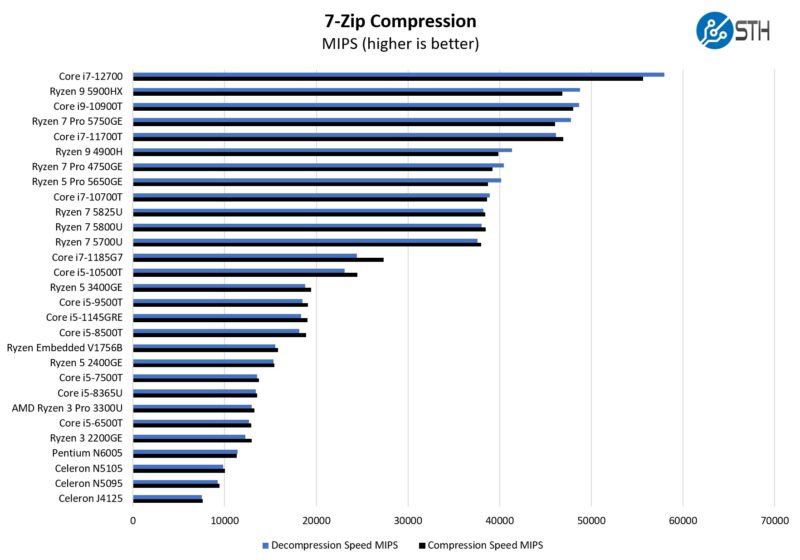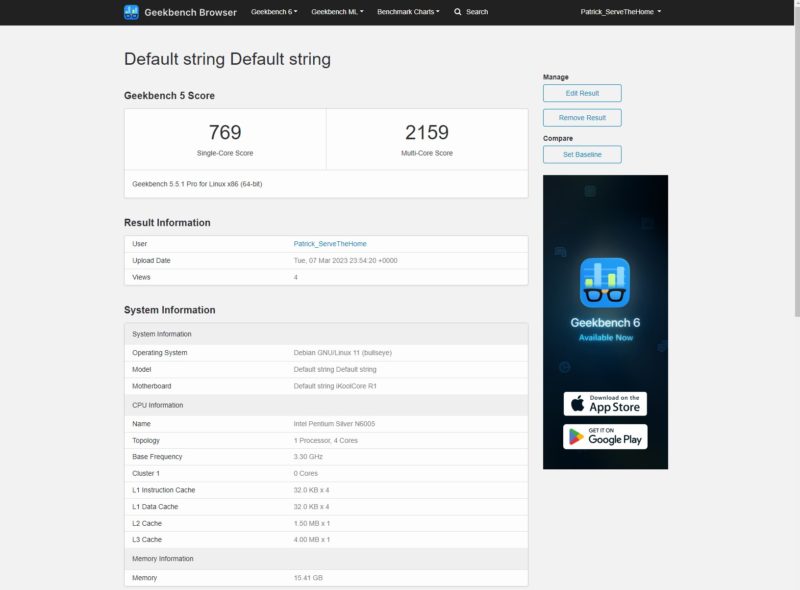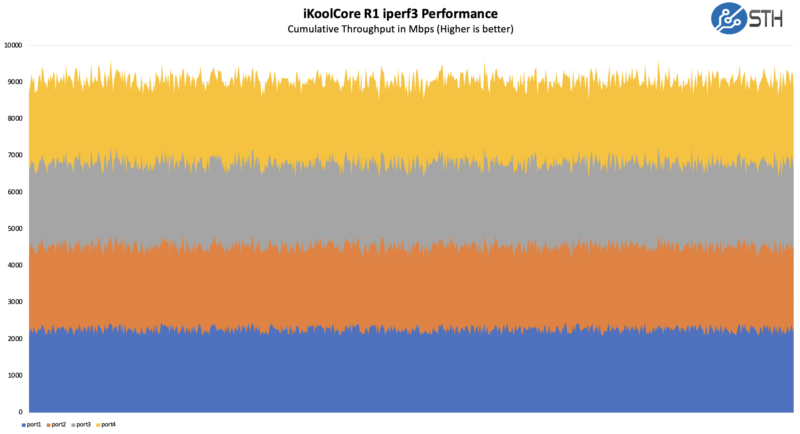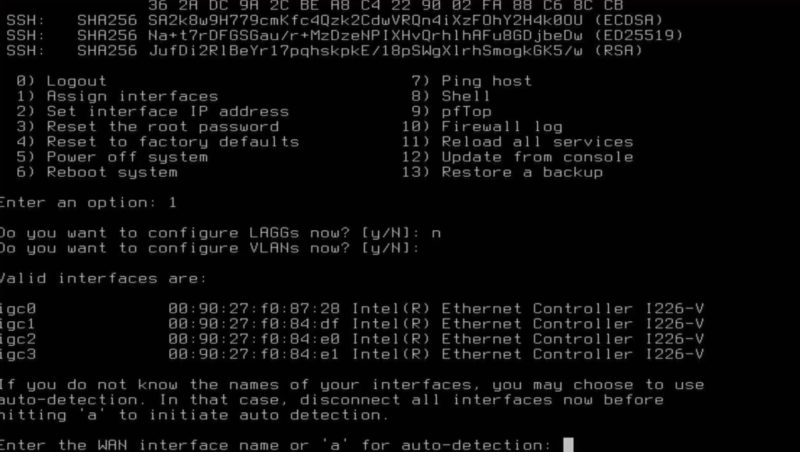iKoolCore R1 Performance
Instead of going through the entire Linux-Bench test suite, we are going to show a few performance and power numbers here to give a general sense of performance. This also gives us the opportunity to test with Linux/ Ubuntu instead of just Windows.
Python Linux 4.4.2 Kernel Compile Benchmark
This is one of the most requested benchmarks for STH over the past few years. The task was simple, we have a standard configuration file, the Linux 4.4.2 kernel from kernel.org, and make the standard auto-generated configuration utilizing every thread in the system. We are expressing results in terms of compiles per hour to make the results easier to read:

Here the Intel Pentium N6005 performs about how we would expect.
7-zip Compression Performance
7-zip is a widely used compression/ decompression program that works cross-platform. We started using the program during our early days with Windows testing. It is now part of Linux-Bench.

We have tested a number of these chips over the last year or so, and so the N6005 is a known quantity.
OpenSSL Performance
OpenSSL is widely used to secure communications between servers. This is an important protocol in many server stacks. We first look at our sign tests:

Here are the verify results:

One benefit to this unit is that the cooling is fairly decent, so it is able to keep the unit cool over load.
iKoolCore R1 Geekbench 6 and Geekbench 5 Performance
Geekbench 6 is not the best multi-threaded benchmark, but in this performance range, it is decent. Here are the Geekbench 6 results from the unit:

Here are the Geekbench 5 results if you would prefer to see those.

Again, this is about what we would expect. Feel free to test your own machines or check those on the Geekbench browser to compare.
OPNsense Performance
We wanted to see if we could pass traffic through this unit as a firewall-like deployment with two WAN to two LAN and doing NAT between the networks:

This is a fairly solid performance. It is similar to what we have seen on the fanless units.
Next, let us get to the OS Testing and our key lessons learned.
iKoolCore R1 OS Testing
We ran the iKoolCore R1 through a number of OSes. If you do want to run this unit with Windows, you will need to add an i226 driver. Beyond that, let us take a look at a few more OSes.
The iKoolCore R1 ran VMware ESXi 8.0 easily. One can even see the 2.5GbE link up in the ESXi Host Client below.

OPNsense 23.1 was working with the i226-V and that is what we used for our iperf3 testing.

pfSense 2.6.0 still does not support the Intel i226-V so you will need pfSense Plus or a development branch.

The iKoolCore R1 ran with Ubuntu 22.04 Desktop and Server even letting us get to the STH main site quickly.

Our unit actually came pre-installed with Proxmox VE, but we did not know the default password. We re-installed it and it worked. Here is the topology diagram of the unit when we had Proxmox VE installed.

Here is the lscpu output from Proxmox VE 7.3:

Overall, this runs many OSes fairly easily.




There are obvious reasons to prefer the dedicated hardware(that little fan definitely isn’t ‘shove into corner, forget about for a decade’ material); but it feels downright weird to see 4x 2.5GbE NICs and an entire computer, albeit a deeply undistinguished one, sitting only $50 higher than the MS105 5-port unmanaged switch.
Totally agree. Hoping Thursday this week we launch the “cheap” 2.5GbE switch round-up/ buyer’s guide.
This thing looks like it ought to fit in very nicely with all the other Raspberry Pi-sized boxes out there. And who wouldn’t want a “cute little pet computer” adorning their desktop? :-)
Professional IT male experts with giant rack cabinets in their living room should not feel threatened by this. It is okay to admit that you like cute hardware.
Nice unit, but the core problem is that alot of libraries now are compiled with SEEE2 and AVX2 by default, and this cpu plattform doesnt support it.. I met this the hard way the other day. Even RabbitMQ AMQP messagebus container by default is using avx2..
I’d like to see all these mini things with vPro iKVM – I know that we can get other solutions, but it would be nicer and easier with iKVM.
Here’s a use-case: routers for RV travelers. With Starlink being viable mobile (albeit stationary) broadband, a power-sipping pico-sized fanless router absolutely makes sense. You could also bind the WiFi link to the WAN side of things and connect to any available public WiFi network (though double-NAT may become an issue).
Is the “IKoolCore R1 Topology” on page 3 human made in Visio / photoshop or is a software that pulls all of those details from the host and does that nice image?
Very interesting find! May give it a try as a low-power draw OPNsense router.
Like mevtec, I’m also wondering how the image “IKoolCore R1 Topology” on page 3 was generated.
@mevtec I’m pretty sure that it’s lstopo output. Provided by hwloc; though normally to be found in, or not too far outside, standard repositories of common Linux distributions.
https://www.open-mpi.org/projects/hwloc/
Amazing unit. Thank you for your review
Thanks for you review. I bought the unit and while testing I found out there are no I226 drivers for Windows server? Win11 drivers don’t work. Did anyone see the driver around? I checked, there are couple bundles on intel website, but i226 isn’t included in any of them :(
Thanks for you help.
It is something I was looking for!